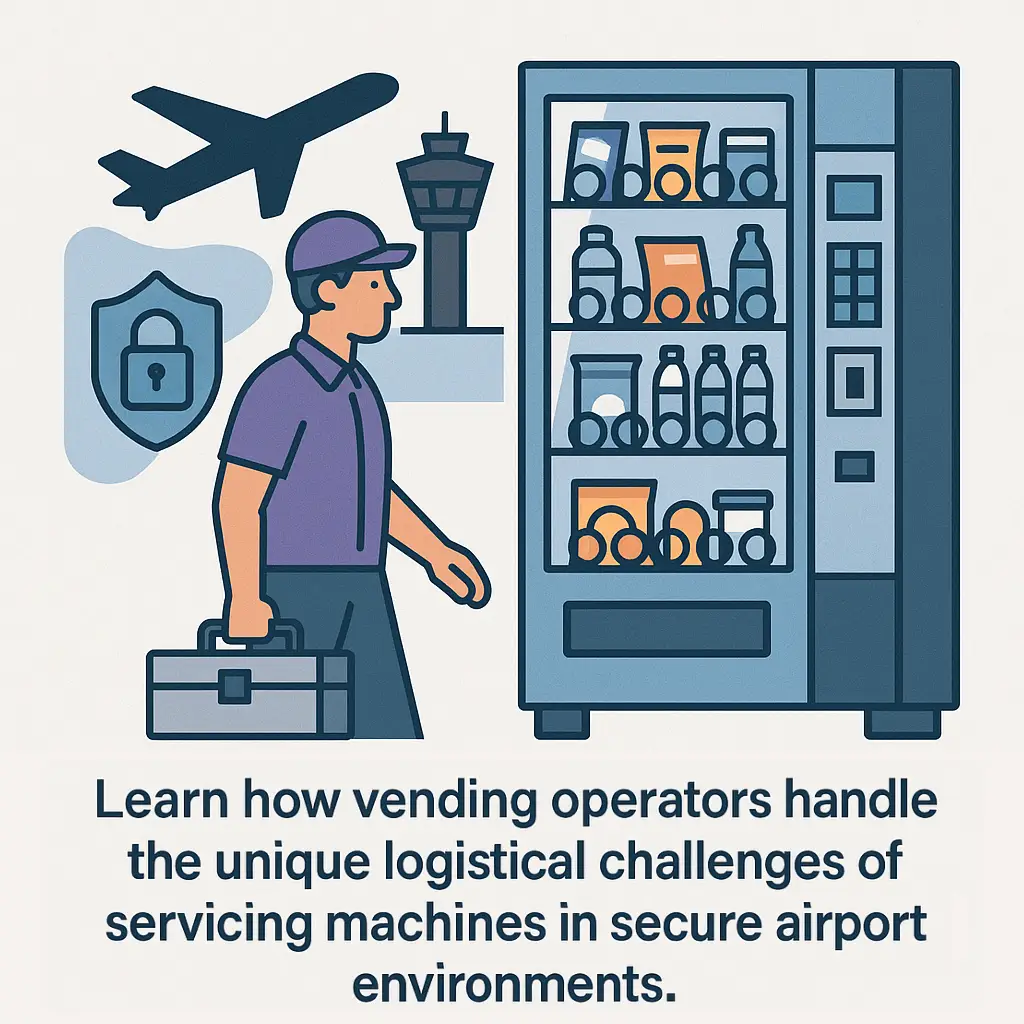Managing Airport Vending Logistics
Learn how vending operators handle the unique logistical challenges of servicing machines in secure airport environments.
Back to Vending for Airports ResourcesLearn how vending operators handle the unique logistical challenges of servicing machines in secure airport environments.
Back to Vending for Airports ResourcesAirports require additional security clearances, off-peak service scheduling, and careful coordination with airport authorities to ensure vending operations run smoothly.
![]() Security checkpoints complicate access to vending service areas
Security checkpoints complicate access to vending service areas
![]() Tight windows require precise restocking coordination
Tight windows require precise restocking coordination
![]() Passenger volume drives higher product turnover
Passenger volume drives higher product turnover

Managing vending in airports requires far more planning than standard commercial locations. Security protocols, limited access times, and high passenger volumes all shape how machines are stocked and maintained. Unlike traditional workplaces or schools, airport environments operate under strict regulations that require coordination with multiple airport authorities.
Airport security rules heavily influence logistics. Service teams often need background checks, ID badges, and scheduled access to restricted zones. This process requires advance planning to ensure compliance and avoid delays. Missed access windows can lead to significant downtime and empty machines, which can affect traveler satisfaction. For more on how vending can adapt to unique environments, explore our insights on warehouse logistics.
Servicing typically occurs during early mornings or late evenings to minimize disruptions to passenger flow. These narrow service windows leave little room for error. If a team misses its scheduled time, restocking may be postponed until the next approved slot. This makes precise planning critical. Understanding and adapting to these constraints is key to maintaining consistent service levels. See how other specialized environments handle similar challenges in school installations.
Airports have constant foot traffic, which creates a fast product turnover. Machines near gates or baggage claims often require multiple restocks per day to keep up with demand. Real-time inventory tracking and predictive stocking models help prevent stockouts. A well-planned schedule ensures that passengers always find what they need. Learn how technology can support efficient service in our overview of smart vending trends.
Airport vending requires collaboration with airport security, operations, and concession management teams. Each department has its own processes and requirements, which must be navigated effectively to avoid bottlenecks. Clear communication and scheduling are essential to streamline operations. For more guidance on structuring service agreements, review our article on contract essentials.
If you're exploring vending options for your business, Vending Exchange can help simplify the process. Delivery, Installation and Equipment is provided at no cost to you - vendors provide the machines, keep them stocked, and handle all servicing. Whether you need a provider or full-service management, just fill out the form on this page to get started.
Airports have heightened security protocols, limited access times, and more frequent restocking demands, making logistics more challenging than typical commercial sites.
Servicing usually occurs during early mornings or late evenings to minimize interference with passenger flow and align with security access windows.
Teams must coordinate with airport authorities for access, often requiring background checks, badges, and adherence to strict time slots.
Missing a scheduled slot can delay service until the next approved window, potentially leading to empty machines.
Frequent inventory monitoring, predictive stocking, and well-planned delivery schedules ensure popular items stay fresh and available.
Yes. Personnel typically need background checks, ID badges, and ongoing clearance renewals to access secure zones.
Depending on passenger volume, machines may be restocked once or multiple times daily to meet demand.
Common items include bottled drinks, packaged snacks, travel accessories, and other carry-on-friendly essentials.
Machines are placed strategically in high-traffic yet unobtrusive areas, and servicing is scheduled during off-peak hours.
Logistics teams must quickly adapt their schedules and protocols, often working with airport authorities to maintain compliance.